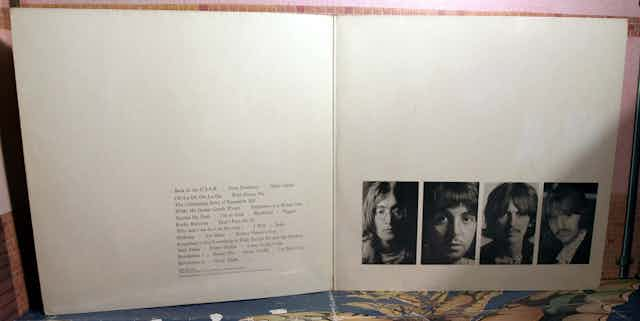For an LP with a plain white cover, the Beatles eponymous ninth studio album – more commonly referred to as the “White Album” – has generated a mass of symbolism since its release 50 years ago in November 1968.
With its glossy all-white gatefold cover, black inner sleeves and portraits of the Fab Four hidden inside the sleeve, the influence of the White Album can be traced across a huge range of cultural artefacts. For example, the author of New Journalism, Joan Didion, named her study of the end of the 1960s dream, The White Album. The starkness of the LP’s presentation seemed aligned to the collapse of post-war idealism documented by Didion’s book.
For cult leader Charles Manson, the record contained a litany of hidden messages that only he and The Beatles understood. George Harrison’s Piggies and Paul McCartney’s (admittedly crazed) Helter Skelter foretold the chaos of a bloody race war, a new apocalypse that Manson was to instigate and alone survive.
Read more: Revolution 50: The Beatles’ White Album remixed
In 2004 Brian Joseph Burton, AKA Danger Mouse, issued The Grey Album, a mash-up of The Beatles and rapper Jay-Z’s The Black Album.
And, as if the cultural and commercial importance of the White Album could be doubted, a re-issue of the record to coincide with its 50th anniversary went into the Billboard top 200 with a bullet at number six. Interestingly, of the 63,000 units sold in the week from November 9 to 16, 52,000 were in traditional album sales.
After Sgt Pepper’s
The album remains the Beatles’ most intriguing contribution to the art of sound. It’s hard to imagine in today’s landscape of remakes, sequels and parodies that the pop fans of the 1960s expected their favourite artists to keep moving forward and with each new recording to have developed something entirely fresh. So, the lush, psychedelic world of the previous LP Sgt. Pepper’s Lonely Hearts Club Band, with its iconic Peter Blake designed cover, was substituted by a stark minimalist aesthetic (albeit one created by another legendary British pop artist, Richard Hamilton).
The music inside Hamilton’s sleeve revealed a similar shift of gear. For practically the first time, Beatles songs appeared as solo efforts – some of the record’s 30 tracks had even been recorded by a single member of the band. This had occurred before (think of McCartney singing Yesterday accompanied by a string quartet or Harrison’s forays into Eastern mysticism) and yet for the first time the group was revealed as a collection of individuals rather than a well-oiled unit.
As the late Roy Carr, who co-wrote one of the best books on the group, The Beatles: an Illustrated Record, put it, “on this double LP they act as each other’s session men”. The individual characters of each group member were also laid bare: Lennon’s dark cynicism, McCartney’s eclectic optimism, Harrison’s mysticism and Starr’s love of country music. The collaborative aspect of a pop/rock group dynamic had begun to dissolve. The White Album in fact marks the clearest instance of the disintegration of the Beatles as a group and was thus the springboard for the various solo careers of the band, with tantalising glimpses – good and bad – of what was to come in the years following the split.
It is the sprawling mixture of music and ideas on the record that makes is so fascinating, especially in hindsight. For example, Revolution 9 is a tape collage put together by Lennon and Yoko Ono echoing the experiments in this field by RTF and GRM in France and the BBC Radiophonic Workshop in the UK and reviewed by the NME at the time as a “pretentious piece of old codswallop”. Birthday and Helter Skelter contain distorted blasts of guitar prefiguring Heavy Metal. McCartney was here trying to top The Who: “Pete Townshend said I Can See For Miles was the dirtiest, filthiest record ever, so we were trying to out-filth The Who.”
There is also Lennon and McCartney’s trademark virtuoso vocal performances set to new diverse means (I’m So Tired, Happiness is a Warm Gun and Martha My Dear) and moments of great beauty such as Lennon’s tribute to his deceased mother: Julia.
Growing pleasures
The Beatles’ closet allies though believed they had gone too far. Their producer, George Martin, probably recalling the perfection of albums such as “Revolver” (1966), famously declared on the Anthology documentary: “I thought we should probably have made a very, very good single album rather than a double,” while stalwart engineer Geoff Emerick described the LP as “unlistenable”.
Yet ultimately it is the messiness and eclecticism of the White Album that makes it so great – an aspect I tried to capture in my book of individual reflections on the songs on the LP by artists, poets, academics and performers. The White Album is perhaps the truest deconstruction of The Beatles as a unique group of musicians that we have.
And still the LP continues to fascinate. New York artist Rutherford Chang’s response to the record is an obsessive project. Since 2006, Chang has collected as many copies of the LP as he can, no matter the state of decay (he currently holds around 2,200 copies). In fact, it is the individual modifications (markings and collaging on the cover, and so on) that make the collection so unique. Chang has also sonically layered multiple copies of the LP one on top of another so that those so familiar songs become unrecognisable – a phased mush of noise.
This is precisely the kind of iconoclastic experimentation that the Beatles themselves hoped to achieve with the original 1968 project.
The White Album may have contained the first hints at the limits to the Beatles longevity as a group. But its avant garde eclecticism, or what Beatles biographer Barry Miles referred to as “multipurpose Beatle music”, is one of the very things that ensures their work continues to inspire and provoke creativity 50 years on.

